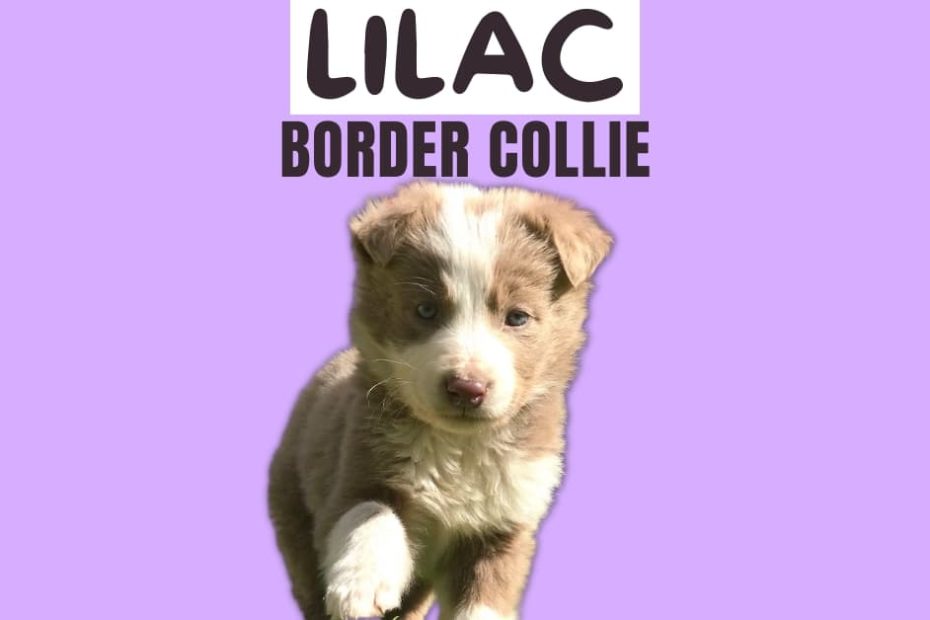Have you ever heard of a lilac Border Collie?
Border Collies are some of the most intelligent dogs on the planet. Still, if you expect only to see black and white, brown and white, or tri-color Border Collies, you’re missing the wide variety these beautiful dogs can display with the right genetics!
One of the rare color combinations is lilac.
This cool brown tone shows up when a puppy has homozygous recessive genetics for their B and D locus, which controls black or brown coloration and non-dilute or dilute coloration, respectively [1]gooddog.com/health-hub/understanding-canine-coat-color-genetics.
In this article, I will cover the following:
- What is a Lilac Border Collie?
- Border Collie Coat Genetics
- Health Issues from Lilac genes
- Other rare Border Collie colors
What is a Lilac Border Collie?
In the simplest sense, a lilac Border Collie is a dog with a lighter cool brown coat color. It is either on its own as a solid color, a solid color with markings, a marled pattern with darker patches mixed in, a mix with white in solid or merle, or a tri-color in solid or merle.

In terms of genetics, these extraordinary dogs have both the bb recessive and the dd recessive traits, which we’ll cover in more depth in the next section.
For a quick overview on this unique coat color, check our Lilac Border Collie video:
[lyte id=’tC6yRYgksKU’ /]
Beyond coat color, the lilac Border Collie will have the same traits as other Border Collies for the most part, including high levels of intelligence, high energy, and a solid drive to work hard.
Though Border Collies are often found on farms, handling jobs such as herding flocks of sheep and herds of cattle, they also do very well in the show ring. They have a strong athletic capability and do well as part of an active family that can keep them moving.
These vivacious canines aim to please and will push themselves as far as they can, making it essential for their humans to keep an eye on their exertion level as they grow older if the dog doesn’t recognize that their physical limitations have changed.
Border Collie Coat Genetics
Before we get into lilac Border Collie genetics, let’s look at dog coat color genetics in general.
Dominant black hair genes
Several factors will control what color a dog will come out, but at the most basic, a dog with BB (homozygous dominant) or Bb (heterozygous) genetics will have black hair.
Red, brown, and black genes
A dog with bb genetics will have “red” hair, showing up as a shade of brown. The BB will always pass a dominant black gene along. This causes offspring to produce black color in their coat.
A Bb dog can pass either B (black) or b (red/brown) coat genetics onto its offspring, even though it has black showing in its appearance or phenotype.
By comparison, a bb dog will always have brown or red, but depending on what it’s bred to; the puppies may have black or brown genetics because bb is recessive.
This form of color genetics, black or brown, is common across various mammals, including sheep, cattle, rabbits, and cats [2]youtube.com/watch?v=uLEisZeVr-o.
However, carrying black or brown doesn’t mean the dog will be black or brown, only that it can produce that color of hair if it can produce colored hair.
Different colors
To gain different shades, three genes are involved. A black dog or red dog will have DD genetics controlling the amount of eumelanin that is expressed, allowing full, rich color, or Dd genetics, giving them dominant full-color coats.
However, if a Dd dog passes on the recessive gene to a puppy or a dd dog is born, they’ll have a diluted color, giving us a lighter color such as charcoal grey or tan.
II genetics will reduce dilution, while Ii will appear less dilute but can pass more dilute genes onto offspring, and ii recessive genetics lightens color even further, ending up in tones of platinum, cream, or similar light tones.
White Border Collie
This differs from white markings, which are pretty standard on Border Collies. White Border Collies with darker skin on their ears, nose, and lips are creams and are likely to be healthy, but dogs with very pale red or blue eyes, ears, and lips can have tyrosinase or albinism.
This genetic mutation prevents pigment from forming, which can be a basis for many health issues, which we’ll discuss below.
This is before we even get into mixed markings such as ticking, brindle, merle, spotting, or agouti, patterns that can make the coat even more complex [3]bordercolliesociety.com/border-collie-colors[4]doggenetics.co.uk/dilutes.html#isabella.
The lilac coat explained
Now that we have the basics down let’s discuss what leads to a lilac coat. A lilac coat is the result of the breeding of a chocolate (dd) and a blue (bb) dog.
This mix creates a double recessive on two different alleles or genetic locations on the chromosome. Because these two colors essentially mix, you’ll end up with a dog that is a grey-brown tone.
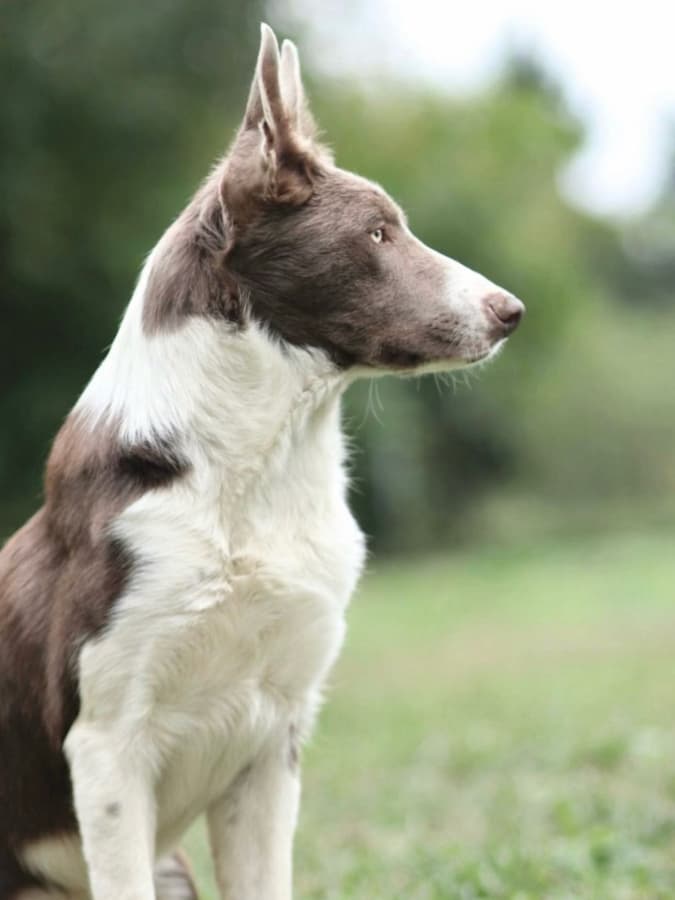
Because of the related effects of these genetics, these puppies will often have a red-eye glow in a darkened room. For about the first full day of life, their ears, lips, and nose will appear lilac in tone, significantly more purple than other puppy coat colors, hence the name.
Isabella coat color
This specific color is called Isabella in other dog breeds, while two different color combinations can also produce lilac tones.
In French bulldogs, as an example, CoCo (a lighter brown) and dd can be mixed to create lilac, while a three-part combination that is very rare incorporates dd, bb, and CoCo to create what is known as “new shade” lilac.
As CoCo is more difficult to breed for, “new shade” lilac tends to be the rarest. Isabella lilac is the most common [5]youtube.com/watch?v=EzrV351UIuM.
Recessive Genes
Before we get into how lilac Border Collies are created, you’ll have noticed the use of the term dominant and recessive genes.
But what does that mean?
A dominant gene will show up over other genetics. As an example, using our above samples, a Bb dog bred to a Dd dog will most likely have the following:
- 25% BD puppies that appear black,
- 25% Bd puppies that appear blue or a charcoal grey color,
- 25% bD puppies that will appear brown,
- and 25% bd puppies that appear lilac.
By comparison, breeding a bb dog to a dd dog will result in only bd lilac puppies, while breeding a BB dog to a DD dog will only result in BD black puppies because these are the only combinations possible.
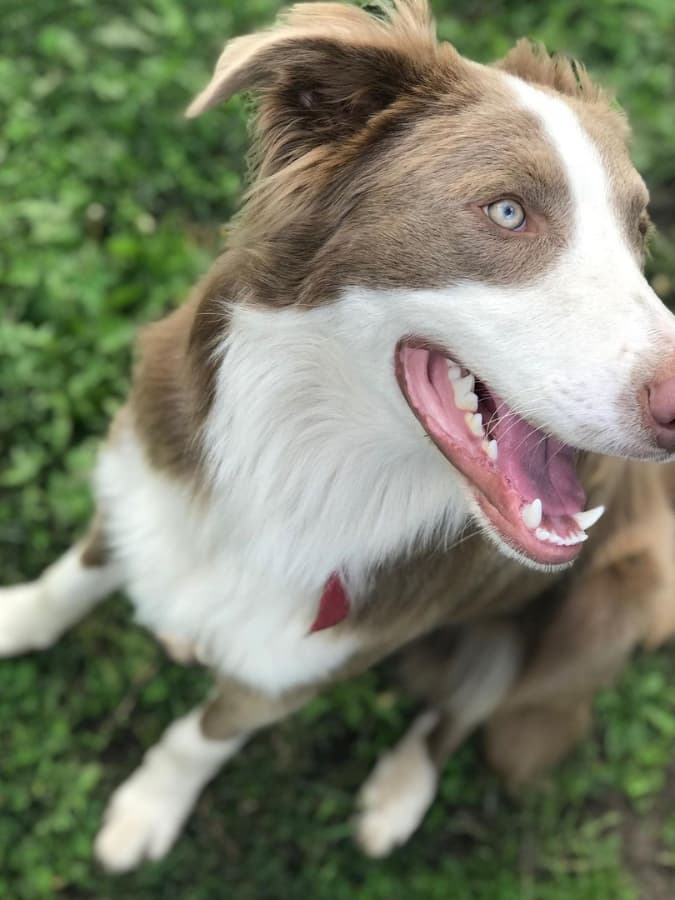
d is a recessive dilute gene to D.
This is one of the reasons why puppy breeders must also be at least armchair geneticists so that they understand the potential issues that can arise from genetic crosses that can cause health problems, such as double-merle.
Lilac Border Collie Health Problems
As compared to some other combinations, such as double-merle causing blindness and deafness, breeding for lilac isn’t dangerous per se, but it can cause some health problems for your dog.
In the last example, double-merle, the color genetics and dilution become too pale, causing a type of albinism that can leave the dog blind or deaf due to lack of pigment in the eyes and ears.
Similarly, the double-recessives required for lilac can also cause issues with the skin [6]pets.webmd.com/what-to-know-about-the-lilac-dog.
Alopecia
Lilac coats tend towards a disorder called alopecia, or hair loss. The lower amount of pigment in the hair itself can cause the hair to be thinner, which can increase the chance of sunburn or skin irritation.
This, in turn, causes itching, which may be the source of hair loss or may be caused by the hair loss of alopecia.
Skin issues
The exposed skin can become flaky, itchy, red, and irritated, making your lilac dog miserable. That being said, this is a disorder that, though at a higher instance in lilac dogs, doesn’t occur in all lilac dogs.
If you’re considering purchasing an adult lilac that appears to have a full, healthy coat, you probably won’t face these issues or the cost of medication for skin problems that can occur [7]akc.org/expert-advice/health/alopecia-dogs.
How much is a lilac Border Collie?
Because of their rare genetics, lilac Border Collie dogs can demand a premium. In many cases, good breeders will provide genetic testing to prove that they have a true lilac rather than a dog that “looks” lilac.
However, these animals will also come at a higher cost.
For example, a pet-grade lilac, which does not meet breed standards, may be found for $700-$1600. Still, for a breed-standard, papered, genetically-tested lilac puppy, expect to pay upwards of $11,000, especially if it’s one of the rare combinations that include CoCo genetics in the lilac color [8]theguardian.com [9]marvelousdogs.com/border-collie-price.
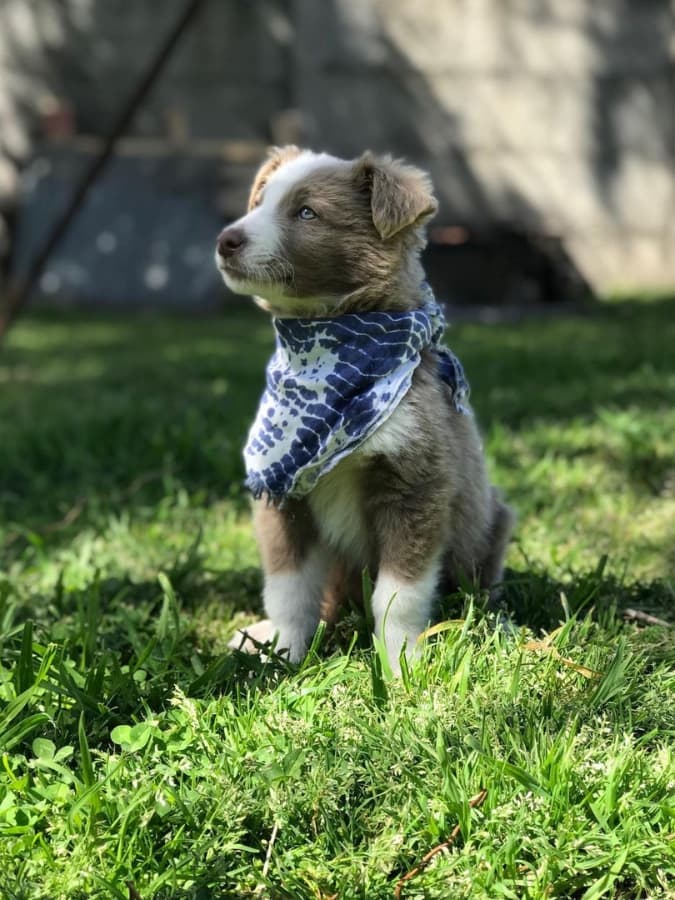
Standard Border Collie Colors
Many colors, patterns, and markings are allowable under the breed standard, provided white markings do not dominate the coat.
These include black, blue, gold, red, sable, seal, slate, and lilac. They can also have unique patterns, including solid colors with white, merle, brindle, and ticked.
This level of diversity provides a wide range of possibilities, including tri-color Border Collies and markings such as masks, points, and similar options. Borders can have white patches throughout their coat.
They can have a white chest with a dark base color, such as black. This coat pattern is referred to as tuxedo.
Unique Border Collie Colors
However, several colors are pretty unique among Border Collies. These include white, sable, red, merle, and brindle Border Collies or “tigerstripe.”
These are caused by various genetic alleles that can be turned on, including the A, B, D, E, H, K, M, and S alleles [10]gooddog.com/health-hub/understanding-canine-coat-color-genetics.
Sable Border Collie
Sable Border Collies have a specific agouti gene active, which allows a pattern along the hair bands.
The easiest way to test for sable genes is to blow on a dog’s coat until it forms a circle of hair growing out from one point.
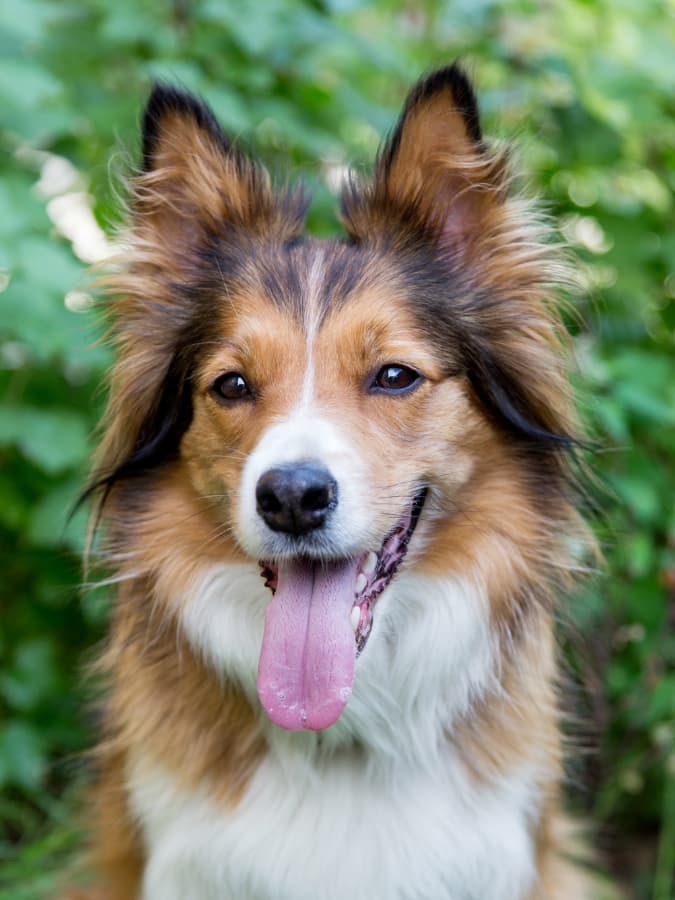
If you can see multiple bands of color forming the circle, or for sable, a brown circle surrounded by a black circle, the dog has an active agouti gene. This gives the dog the appearance of having a translucent black veil over a brown coat, which can be very striking.
White Border Collie
A white Border Collie can be bred in two or three ways. A Border Collie can have excessive white markings, which dominate the coat and make it unregisterable under the breed standard.
The American Kennel Club does not recognize a pure white coat in the Border Collie breed standard. However, dogs may have white as the base color.
A white dog could be a double merle, which is the breeding of two merle or two merle-carrier dogs to each other. The third option is that it could be a true albino Border Collie, often referred to as lethal white.
The first type, should it have darker eyes and a colored head or ears, will be able to enjoy a full and healthy life without any limitations, despite the old shepherd’s tale about white collies not working well with sheep due to their similarity in color.
However, a double-merle who does not have a colored head or a full albino Border Collie may have significant issues with blindness and deafness, especially if the eyes are pale and the ears are not colored [11]bordercolliehealth.com/white-border-collie.
Red Border Collie
Red Border Collies may be true red, Australian red, or gold. This color combines bb genetics to produce red and ee genetics to lighten the brown to a beautiful red color that may bring other red dogs, like Lassie, or a red fox’s coat to mind.
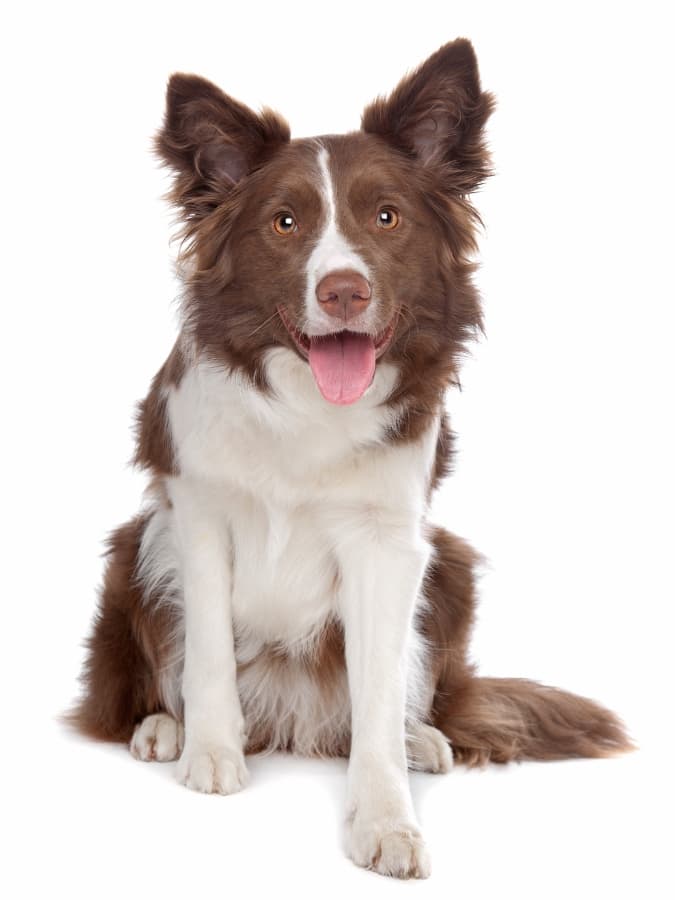
However, if bb and ee genetics are combined with dd genetics, you’ll often end up with a lighter blonde or cream dog featuring a darker nose, ears, and lips with a diluted coat that will appear a pale yellow or red tone [12]hepper.com/dog-color-genetics.
Additional Rare Border Collie Coat Colors
There are a few other unique Border Collie coats that you may stumble upon that are worth mentioning. These are:
- Saddleback Sable Border Collie (Saddleback Sables)
- Blue Tricolor Border Collie (Blue Tris)
- Sable Merle Border Collie
- Gold Border Collie
- Chocolate Tricolor Border Collie (Chocolate Tri)
- Slate Merle Border Collie (Slate Merles)
The Merle Coat
A merle coat is a beautiful mix of dilute and solid coloring within the same dog. The coat will have combinations of a dilute color with a deeper non-dilute tone sprinkled in, often with patches of white and other markings such as tan points and black masks.
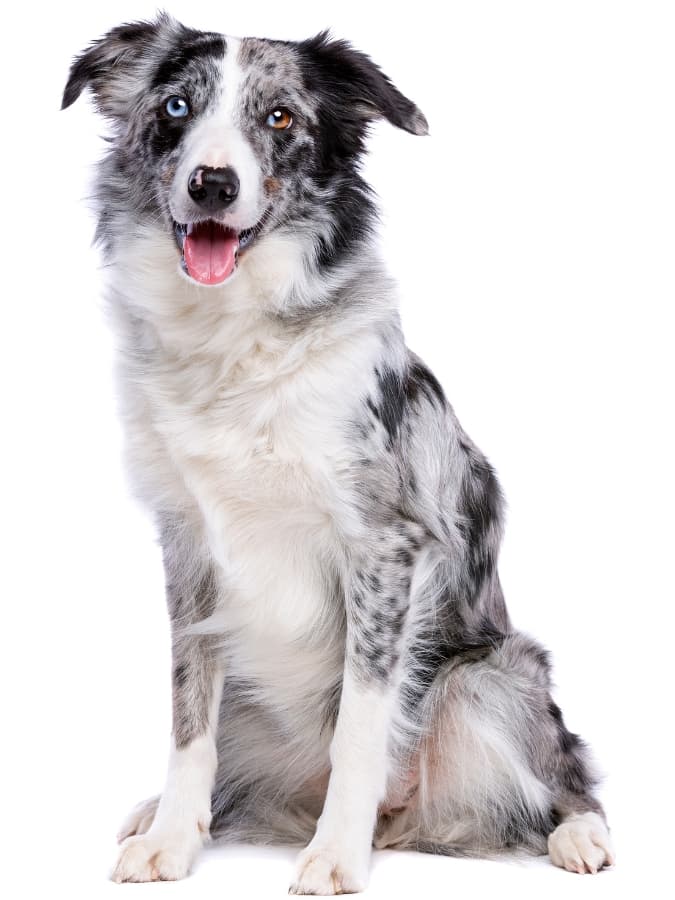
The merle coat is on the M allele. The dominant merle gene is expressed as M. Recessive m is non-merle.
However, if you’re interested in a merle dog, you’ll want to look for one that is heterozygous Mm, where they have a non-merle gene.
Although the merle pattern is beautiful, it can pose some serious dangers.
This is because a double merle, or MM, has too much dilution and merle in their coats, causing them to be mostly white and leading to significant risk for serious health concerns, including blindness and deafness [13]doggenetics.co.uk/merle.
Red Merle Border Collie
For a red merle, you’ll need red genetics, which will include bb and ee, and the heterozygous merle gene Mm.
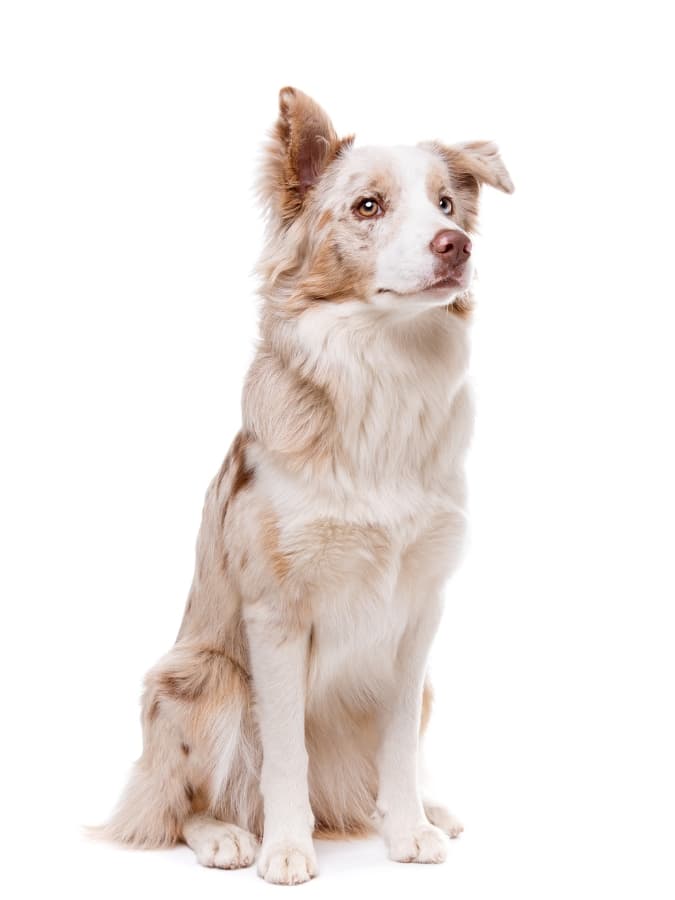
Without the merle gene, you have the genetic mix behind red Border Collies.
Blue Merle Border Collie
By comparison, the blue merle will be BB homozygous or Bb heterozygous with dd dilution, in addition to the heterozygous merle gene Mm.
Blue Border Collie
Blue Border Collies, without the merle gene, are relatively rare. The American Kennel Club recognizes the color blue as a standard breed color.
Lilac Merle Border Collie
The lilac merle Border Collie is among the rarest. Lilac refers to a light, almost purplish hue. Merle refers to the spotty and dappled pattern. I am not sure many Border Collies express the right pairing of genes for this coat.

Thus, a lilac merle Border Collie will have a light-colored merle coat. This unique coat is often seen in French Bulldogs but requires selective breeding practices. A lilac merle French Bulldog can be well over $10,000.
You can only guess how expensive a lilac merle Border Collie would be…
Final Thoughts
As we mentioned in the beginning, dog coat color genetics is a complex but glorious topic, creating a wide range of colors, patterns, and expressions.
If you’re still a bit confused, the easiest thing to remember is to avoid dogs with pale pink or blue albino eyes and white ears, which can cause significant disability. Be aware that lilac Border Collies may have issues with hair loss and skin itching due to alopecia.
A responsible breeder will be sure to conduct DNA tests and health checks on their dogs. It is important to ensure the breeder you are working with follows the best breeding practices.
Even though there are stunning coat colors, you don’t want to support the unhealthy breeding of Border Collies!

References

